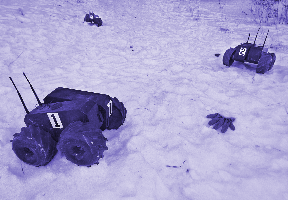
If a skier or snowboarder is buried under an avalanche — and a record number of snow-sports enthusiasts died last year in avalanches in the United States — a major problem for rescuers is how to find the unfortunate person before suffocation or frostbite and hypothermia do. Death can come in half an hour.
“Yelling and pointing are probably not the most efficient ways to conduct a rapid search,” says Sandia researcher Rush Robinett, describing ad hoc cooperation between searchers at the slopes.
Rush has a better, if unconventional, approach.
Computationally, he says, finding a snow-buried skier is remarkably similar to locating the point source of a chemical or biological attack.
His group’s recently developed computer program, which provides group intelligence for a swarm of mini-robots to rapidly pinpoint a source of contagion, can also be used by a group of humans carrying minicomputers, global positioning sensors, and simple radio equipment to find a skier buried in whiteness. In Sandia computer simulations, he says, searchers using the “swarm” algorithm called “Distributed Optimization” found avalanche victims four times faster than simulations of any published search scheme currently in use.
“That’s with conditions as simple as possible,” says Rush. In more complicated situations, where depth of snow burial or rocks or trees created complications, the Sandia algorithm comparatively was even faster. In its primary use for the US Department of Defense, the search algorithm enables cockroach-sized robots to “talk” to each other through radio transmitters and home in on a target far more quickly than solitary searchers using more conventional means. The group search technique, called swarming, relies upon neither a central intelligence telling the searchers what to do nor the intuition of individuals. Instead, each robot continually informs others of its position and of the strength of signal received at that position from the sought-for source. The steady streams of information from multiple sources allow each member of the swarm to continually refine the direction of its search.
The same algorithms, says Rush, can be used by human “platforms” [searchers] to locate buried skiers. Skiers in avalanche country already carry radio beacons as standard operating procedure, though search techniques to locate the beacon usually are not particularly advanced. A standard approach is to exhaustively search every inch of ground — a time-consuming procedure. Another requires the searcher to make a right-angle turn when signal strength decreases. Such searches are difficult because buried obstacles mask the strength of radio signals, and the transmitter’s physical orientation is unknown.
Because of the increased popularity of the ski slopes, according to the Cyberspace Snow and Avalanche Center in Corvallis, Ore., skiing deaths due to avalanche were a record in the US last year, with 33 fatalities in 23 separate incidents. Chances of survival decrease markedly after a half-hour under the snow, says Jim Frankenfield, director of the Center.
Says Rush, “Because finding the location of a radio-frequency sender and finding the center of a region from which some form of lethality is emanating are essentially the same activity, we can solve a whole class of similar problems with the same algorithms. By carrying lightweight radios, GPS positioning devices, and pocket computers programmed with robotic search algorithms, rescuers would be told [via computer screen], ‘South three steps for most efficient path search,’ or some such thing.”
The algorithms are being prepared for patenting and also for publication. Two videotapes of robotic swarms in action demonstrate their effectiveness. Entrepreneurs interested in licensing the use of the algorithm for ski rescue purposes are invited to contact Sandia’s Technology Transfer program
Research was funded in part by Sandia’s Laboratory Directed Research and Development Program.
Last modified: January 26, 2000